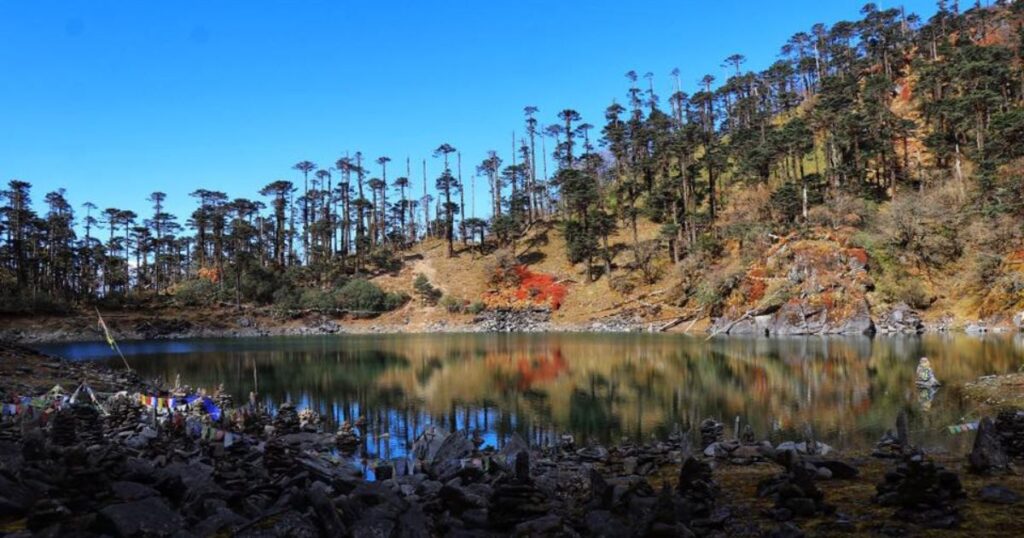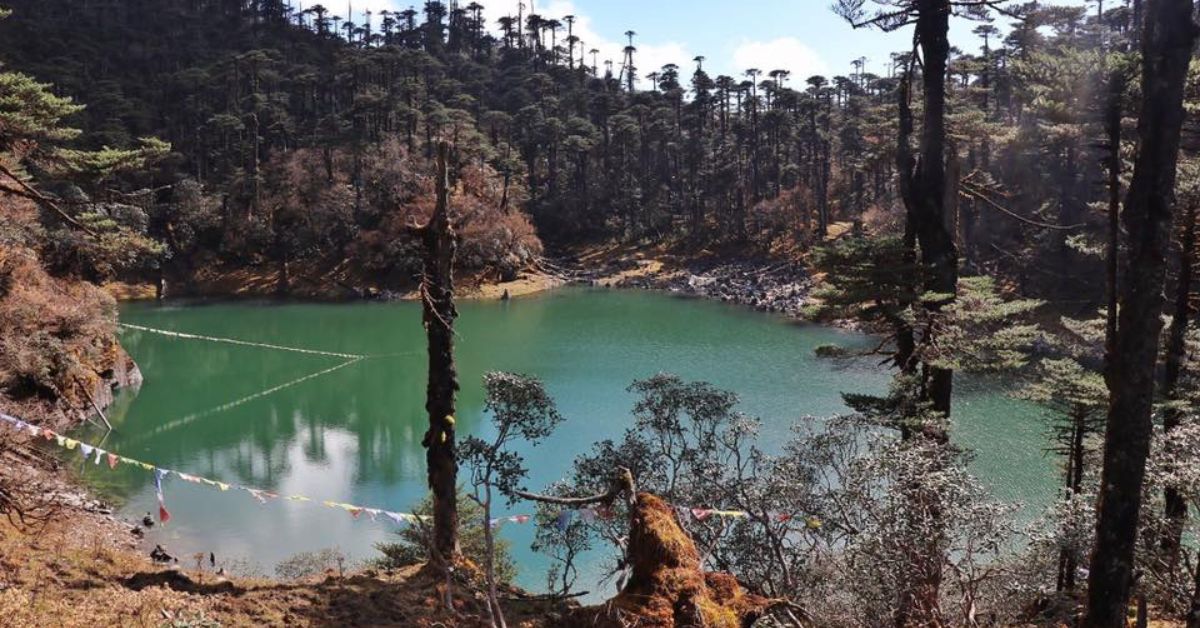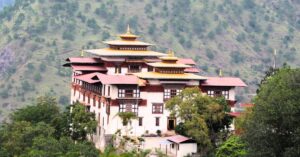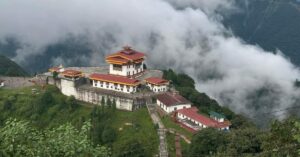Dangling Tsho is the historic lake of Meme Dangling, located in the north of Khaling Gewog, under Trashigang Dzongkhag. The lake, located in a pristine fir forest, can be reached after a 7-hour walk from Khaling town.
Spanning a surface area of more than 3 acres, the Memey Dangling Tsho remains clean throughout the year. Locals say that two beautiful white ducks constantly sweep up all the twigs and leaves that fall onto the lake from the nearby trees, keeping its surface clean.
How To Reach Dangling Tsho
The hike to Dangling Tsho is breathtaking. The trail begins from Khaling Town and winds through a dense forest of firs for around 7-8 hours before arriving at a beautiful lake.
Also Read: How to reach Domendrel Tsho, a Spiritual Journey to Mandala Offerings of Gyalse Tenzin Rabgye.
Historical Background
According to the legend of Dangling Tsho, Ama Jomo, accompanied by Lam Jarappa and her brother Meme Dangling, fled Tibet with the Brokpas after some of Ponpo Yizang’s loyal followers sought revenge for his death. The story goes that Ponpo Yizang forced his workers to remove the mountain blocking sunlight to his palace. It is said that Ama Jomo sang a song, “It would be better and easier to bring down the mighty king than to bring down the mighty mountain.” Understanding her song, the workers ultimately killed their king, which led to Ama Jomo and her followers escaping to Bhutan.
Upon arriving in Bhutan, Ama Jomo divided the Brokpas into three groups due to limited pastureland for yaks and cattle. The Eastern group (Sharpa Dengze) settled in Sakteng. In contrast, the Southern (Lhopa Dengze) and Western (Nuppa Dengze) groups initially settled down at Lung Zempo but later relocated to Sakteng and subsequently to Merak. The ruins of stone houses at Lung Zempo still stand today.
Also Read: The Historical Significance of Kabji-Hoka Tsho, a Lake with an Opening to Stop Overflowing
Origin of Dangling Tsho
The origin of Dangling Tsho is shrouded in mystery. Legend has it that a traveler once camped overnight in the area where present-day Dangling Tsho lies. That night, he dreamt someone asking him to move to a different location. The man refused to move, warning that he shouldn’t be disturbed. By morning, when he woke up, he found himself surrounded by a lake, with only a small patch of ground where he had slept remaining dry. Dangling Tsho has miraculously appeared overnight, and Meme Dangling has declared his new home.
Also Read: How did Drakey Pangtsho, the Treasure Lake of Guru Rinpoche on the Lap of Jowo Drake, get its name?

Meme Dangling Tsho
Dangling Tsho, an ice-fed lake with an area of about 3 acres (1.57 hectares), is the holiest and most historic lake in Meme Dangling. The lake remains clean throughout the year. It is said that two beautiful white ducks constantly sweep away twigs and leaves fallen into the lake.
Visitors are welcomed throughout the year except during Ladam, a traditional practice of closing the mountain to human activity. When visiting, locals say it is important to offer ‘Serkem’, a spirit libation to Meme Dangling.
However, visitors must refrain from taking meat, fish, onions, or garlic, as these are believed to offend their deity and provoke windstorms and heavy rains. We also request trekkers to refrain from pouring milk into the lake.
Also Read: Zhemgang Kheng Buli Tsho, a Promised Lake of Buli Moenmo Kuntu Zangmo
Cultural Significance
The community of Khaling holds profound reverence for Ama Jomo and Meme Dangling. Every year, they perform Jomo-Dangling Soelkha, a feast offering festival in honor of the local deities, Ama Jomo and Meme Dangling. During this event, locals seek blessings for protection, wealth, cattle, and happiness. In return, Ama Jomo and Meme Dangling are believed to grant them bountiful harvests and several healthy livestock.
Also Read: Mebar Tsho, the Burning Lake, where Pema Lingpa discovered Hidden Treasures.
Jomo-Dangling Soelkha
Jomo-Dangling Soelkha is a feast offering festival honoring the local deities, Ama Jomo and Meme Dangling. The feast occurs three times a year, twice by the Khaling community and once by the monks of Trashigang Rabdey. The festival marks the seasonal movement of their deities between their summer and winter abodes.
Summer Soelkha is held on the 14th day of the 4th month at Jomo Dogsa to make offerings for the deities’ journey to their summer residence in Martshala.
During the festival, the villagers gather at Jadrung Lhakhang, where the attire, jewelry, and weapons of Ama Jomo and Meme Dangling are brought out from the Goenkhang by the local shaman. The community then marches toward Jomo Dogsa, believed to be a resting place of Ama Jomo and Meme Dangling.
At Jomo Dogsa, the villagers prepare the deities with masks, attire, and weapons. A shaman then offers a feast and serves brewed wine to the local deities, seeking protection for the people and community. After the offering, people receive blessings and return to the Lhakhang.
Additionally, monks from Trashigang Rabdey visit the Dangling Tsho on the 20th day of the 4th month to conduct their sacred rituals.
Winter Soelkha is observed at Dangrey (Bremang Village) on the 14th day of the 10th month of the Bhutanese calendar to welcome and mark their return from their summer residence.
Also Read: Jo Bay Tsho, a Hidden Lake with a Golden Pillar in Haa
Best Time to Trek to Dangling Tsho
The best time to trek to Dangling Tsho is between April and November, when the trails are dry and the weather is favorable. However, visitors are restricted during Ladam, which begins in the 11th month of the Bhutanese calendar and ends in the 2nd month of the following year. You can visit the sacred lakes in Bhutan with the Bhutan Pilgrimage Package.
Places to explore in Trashigang
Trashigang Dzong: The fortress on the auspicious hill built by Trongsa Penlop Chogyal Minjur Tempa in 1659, following the prophecy of Zhabdrung Ngawang Namgyal.
Chador Lhakhang: A sacred Lhakhang in eastern Bhutan that houses the thumb-size replica of the Chador (Vajrapani) Statue discovered from Yuetsho Lake in Pemagatshel.
Enjoyed reading this blog?




